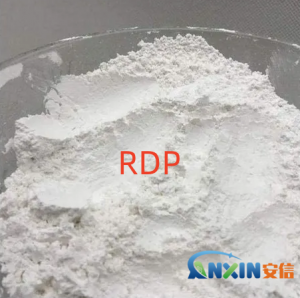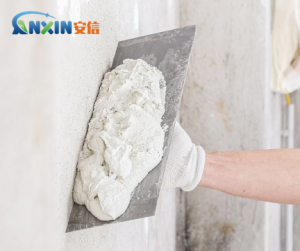In modern building materials systems, putty powder serves as a crucial material for wall leveling and surface finishing. Its performance directly impacts the quality and durability of subsequent coatings or finishes. Water resistance is a key indicator of putty quality. Traditional putty is often based on inorganic binders (such as lime lime, double fly ash, and cement). However, due to its brittleness and poor adhesion, it easily disintegrates upon contact with water, making it difficult to meet the requirements of long-term use on interior and exterior walls. With the application of redispersible polymer powder (RDP), the overall performance of putty, especially its water resistance, has been significantly improved.
1. Basic Properties of RDP
RDP is a spray-dried emulsion converted into a redispersible solid powder. Upon contact with water, it re-emulsifies and restores the original emulsion properties. It is primarily composed of a high-molecular-weight polymer resin, a protective colloid, and additives. Due to its excellent film-forming properties, flexibility, and adhesion, it is widely used in building materials such as dry-mix mortar, tile adhesive, and putty powder.
2. Reasons for Putty’s Poor Water Resistance
Inorganic substrates are brittle: Conventional lime-lime putty or cement putty develops shrinkage cracks after hydration, resulting in a loose structure and easy water intrusion.
Inadequate Adhesion: The interfacial bonding between the putty and the base wall and coating is weak, making it prone to bulging and falling off in humid or submerged environments.
High Porosity: Traditional putty powder has a poor structural density and numerous capillaries, making it easy for water to penetrate and cause pulverization.
Therefore, relying solely on inorganic binders cannot guarantee the long-term water resistance of putty. Modification with polymers such as RDP is necessary.
3. Mechanism of RDP’s Improvement of Putty’s Water Resistance
3.1. Film-Forming Effect
After RDP is dispersed in water in putty, it forms a continuous polymer film during the hardening process, evenly enveloping the inorganic particles. This significantly reduces the internal porosity of the putty, thereby reducing water permeability.
3.2. Enhanced Adhesion
The polymer film penetrates the micropores of the base layer, creating a dual “physical anchoring + chemical bonding” effect. This strengthens the adhesion between the putty and the substrate, preventing it from falling off even in humid environments.
3.3. Improved Flexibility and Crack Resistance
Putty is prone to cracking due to shrinkage or temperature and humidity fluctuations, and cracks become a major channel for moisture to enter. RDP imparts excellent flexibility and extensibility to the putty, dissipating stress and reducing crack formation, indirectly improving water resistance.
3.4. Improved Anti-Powdering Ability
Traditional lime-lime putty easily powders when exposed to water. However, the polymer skeleton formed by RDP in the putty significantly enhances its structural stability, preventing powdering caused by water erosion.
4. Effects of RDP in Water-Resistant Putty
Significantly Improved Water Resistance: Experiments have shown that putty containing an appropriate amount of RDP maintains surface integrity after 24 hours of immersion in water, with no noticeable blistering or peeling. Improved Workability: RDP imparts greater lubricity and water retention to putty, allowing for smoother application and easier application.
Wider Application: Putty infused with RDP is suitable not only for dry indoor environments but also for humid areas such as kitchens, bathrooms, and basements, and even for exterior wall putty.
Extended Service Life: Water-resistant putty effectively resists long-term moisture erosion, extending the durability of wall finish systems and reducing subsequent repair costs.
5. RDP Dosage and Ratio Recommendations
The recommended RDP dosage in putty formulations is generally 3%-5% (based on the weight of the putty powder). The specific amount should be adjusted based on the putty type, substrate characteristics, and application environment:
Ordinary interior wall putty: Approximately 3% is sufficient to meet basic water resistance requirements;
Kitchen and bathroom putty: 4%-5% is recommended to enhance water resistance and adhesion;
Weather-resistant exterior wall putty: The dosage can be increased appropriately to ensure resistance to rain erosion and temperature and humidity fluctuations. It’s important to note that RDP is relatively expensive, and adding too much can compromise economics and potentially reduce the hardness of the putty. Therefore, optimization should be considered in a balanced approach to performance and cost.
RDP plays an irreplaceable role in improving the water resistance of putty. By forming a film, enhancing adhesion, and improving flexibility and crack resistance, RDP effectively addresses the problem of traditional putty pulverizing and shedding when exposed to water. This allows the putty to not only meet the requirements of interior wall decoration but also maintain stability in humid and outdoor environments. Appropriate use of RDP not only improves the water resistance and service life of putty but also promotes the development of high-performance, long-lasting building decoration materials.
Post time: Aug-21-2025

